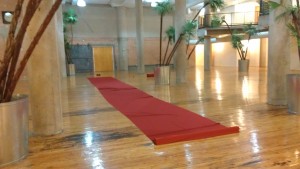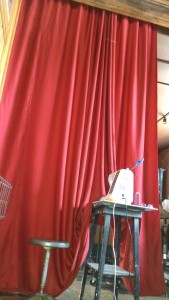I actually worked on this project last month, but have just come up for air after a flood of work with tight deadlines and can finally post about it.
The Project:
One curtain 40 feet long by 12 feet high. Casing at the bottom for a chain; stiff strip along the top to support grommets to attach it to hooks that will go into a track. The fabric is a knit much like suraline (which is very similar to the kind of fabric used in many cheerleading costumes; a thick but relatively lightweight jersey–that is to say, a small amount of stretch, but not a lot).
Also, this is a divider curtain that will be visible on both sides. I didn’t particularly want to self-line it as that would make it extremely thick and heavy, as well as make it take up quite a bit of space at the end of the track when it wasn’t in use.
There’s a legend that when a pope wanted to know if the artist Giotto would be capable enough for a job, Giotto sent him a perfect circle drawn freehand. Panel curtains are kind of like that. They look really simple, and anyone who’s not paying attention will think that being a simple geometric shape makes them easy. They are not. And the bigger they are, the more space there is to wiggle out of line.
So when I discovered my building’s atrium I was overjoyed for the space to lay out enormous curtains flat and have a greater chance of getting perfectly squared corners.
I got the 8 panels cut out, then used the scraps to test ways to hide the seams. My first plan, french seams, was outrageously bulky and caused a lot of puckering. Plan 2 was that seam style wherein one edge is sewn parallel to the other, but closer in, and the longer edge is folded over the short one. This was not only hard to line up on such wiggly fabric, but was also still too bulky. My last option before having to resort to lining it was to find a lightweight fabric with the exact same shade of burgundy.
The chain stores did not have the right shade in the cotton quilting solids, and I was about to test out a not-exactly matching shiny fabric intended to for lining clothes, that would not be invisible, but I that I hoped would at least be close enough to be inoffensive, when I found some misprinted flags in a last chance bin at one of the stores in the warehouse district. The stripes weren’t straight, it wasn’t dyed, but painted on top of crappy white fabric, and the paint wasn’t even, but for 3/8 inch seam facings, I was able to find enough of it to be salvageable.
Once I had all the long seams sewn, back to the atrium to pin the top and bottom. Everyone who passed by thought it was a giant red runway carpet and wanted to know what event I was setting up for.
When I had cut the 8 panels, I left several inches of wiggle room, but this time it all had to be cut perfectly straight. I’ve got a pretty good eye from just over 2 years cutting fabric at Hancock Fabrics. I lined the sides up with the seams of the hardwood floor, cut the top, then measured from that to pin the bottom hem.
The thing about sewing things this large where you can’t see either end of what you’re working on is doing the setup right and then trusting yourself. In the middle of sewing it, the straight edges may start to seem a little crooked. Modifying that while sewing can look right while it’s in the machine, but come out crooked. With something this big, do not eyeball it while it’s wadded up on your sewing table; the most important thing is trusting your cuts and trusting your pins.
Sooo, deliver the sewn item to the client; we get the grommets pounded in, the S-hooks squeezed shut into the grommets and the track runners, get the curtain hung, and it is about an inch too long. I kinda suspected this would happen, but wasn’t sure how much the puffiness of the fabric would counterbalance the weight. Too long is always better than too short anyway.
At this length, I’m able to set up my sewing machine and run the curtain through while still hung.


